2.vue组件化编程
2.1 模块与组件、模块化与组件化
2.1.1.模块
- 理解: 向外提供特定功能的s 程序,一般就是一个js 文件
- 为什么: js 文件很多很复杂
- 作用: 复用js,简化js 的编写,提高 js运行效率
2.1.2.组件
- 理解:用来实现局部(特定)功能效果的代码集合(html/css/js/image…)
- 为什么: 一个界面的功能很复杂
- 作用:复用编码,简化项目编码,提高运行效率
传统方式编写应用:
- 存在的问题:依赖关系混乱不好维护;代码复用率不高
适用于组件方式编写应用:
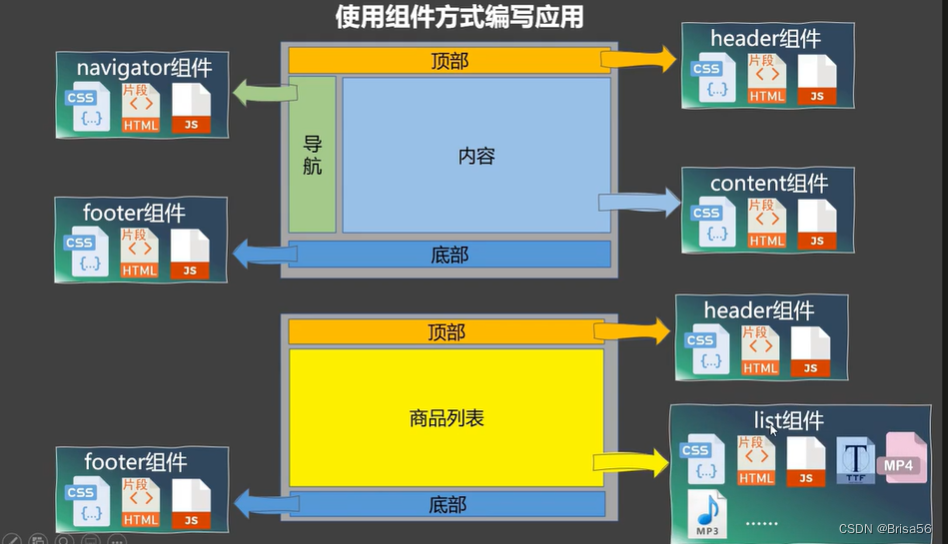
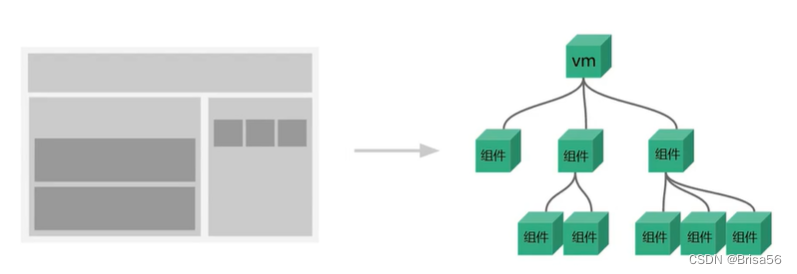
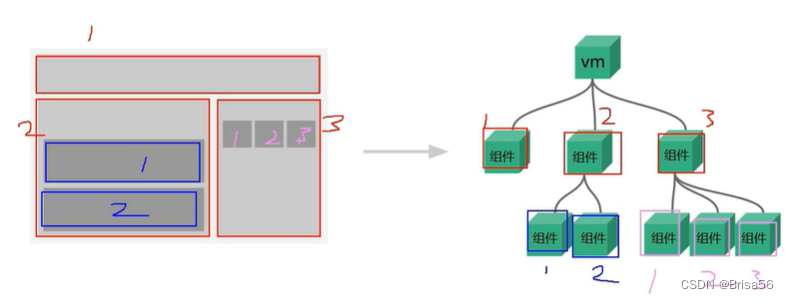
组件:实现应用中局部功能代码和资源的集合
2.1.3.模块化
当应用中的js 都以模块来编写的,那这个应用就是一个模块化的应用
2.1.4.组件化
当应用中的功能都是多组件的方式来编写的,那这个应用就是一个组件化的应用。
2.2.非单文件组件
一个文件中包含有n个组件
2.2.1.基本使用
Vue中使用组件的三大步骤:
一、定义组件(创建组件)
二、注册组件
三、使用组件(写组件标签)
一、如何定义一个组件?
使用Vue.extend(options)创建,其中options和new Vue(options)时传入的那个options几乎一样,但也有点区别;
区别如下:
1.el不要写,为什么? ——— 最终所有的组件都要经过一个vm的管理,由vm中的el决定服务哪个容器。
2.data必须写成函数,为什么? ———— 避免组件被复用时,数据存在引用关系。
备注:使用template可以配置组件结构。
二、如何注册组件?
1.局部注册:靠new Vue的时候传入components选项
2.全局注册:靠Vue.component(‘组件名’,组件)
三、编写组件标签:
<school></school>
<!-- 容器 -->
<div id="root">
<!-- 3使用组件 -->
<school></school>
<hr>
<student></student>
<hr>
<hello></hello>
<hr>
</div>
<div id="root2">
<hello></hello>
</div>
</body>
<script>
Vue.config.productionTip=false
// 1创建school组件
const school = Vue.extend({
template:`
<div>
<h2>学校名称:{
{schoolName}}</h2>
<h2>学校地址:{
{address}}</h2>
<button @click="showMsg">点我提示学校信息</button>
</div>
`,
data(){
return {
schoolName:'1+1',address:'武汉'}
},methods: {
showMsg(){
alert(this.schoolName)
}
},
})
// 1创建student组件
const student = Vue.extend({
template:`
<div>
<h2>学生名称:{
{studentName}}</h2>
<h2>学生年龄:{
{age}}</h2>
</div>
`,
data(){
return {
studentName:'brisa',age:18,}
}
})
// 1创建hello组件
const hello = Vue.extend({
template:`
<div>
<h2>你好{
{name}}</h2>
</div>
`,
data(){
return {
name:'ali'}
}
})
// 2注册全局组件
Vue.component('hello',hello)
new Vue({
el:"#root",
data:{
msg:'lllll',
},
components:{
// 2注册组件 - 局部
school:school,
student,//简写
}
})
new Vue({
el:"#root2",
})
</script>
2.2.2.几个注意点
几个注意点:
1.关于组件名:
一个单词组成:
第一种写法(首字母小写):school
第二种写法(首字母大写):School
多个单词组成:
第一种写法(kebab-case命名):my-school
第二种写法(CamelCase命名):MySchool (需要Vue脚手架支持)
备注:
(1).组件名尽可能回避HTML中已有的元素名称,例如:h2、H2都不行。
(2).可以使用name配置项指定组件在开发者工具中呈现的名字。
2.关于组件标签:
第一种写法:<school></school>
第二种写法:<school/>
备注:不用使用脚手架时,<school/>会导致后续组件不能渲染。
3.一个简写方式:
const school = Vue.extend(options) 可简写为:const school = options
<!-- 容器 -->
<div id="root">
<h1>{
{msg}}</h1>
<school></school>
<school />
</div>
</body>
<script>
Vue.config.productionTip=false
// 定义组件
/* const school = Vue.extend({
name:'atguigu',
template:`
<div>
<h2>学校名:{
{schoolName}}</h2>
<h2>学校地址:{
{schoolAddress}}</h2>
</div>
`,
data(){
return {schoolName:'1+1',schoolAddress:'wuhan'}
}
}) */
//简写
const school = ({
//不写vue.extend,在vm的components里也会被自动解析,这就是可以简写的原因(如果不简写,则是依靠自己的声明完成解析)
name:'atguigu',
template:`
<div>
<h2>学校名:{
{schoolName}}</h2>
<h2>学校地址:{
{schoolAddress}}</h2>
</div>
`,
data(){
return {
schoolName:'1+1',schoolAddress:'wuhan'}
}
})
new Vue({
el:"#root",
data:{
msg:'欢迎学习vue',
},components:{
// 1个单词组成 - 纯小写 或者 首字母大写(与开发者工具呼应)
// 多个单词组成 - 全部小写用-分隔 或者 首字母都大写《结合脚手架使用>
school,//组件名,简写
}
})
</script>
2.2.3.嵌套
嵌套,最后容器中什么都没有写
<!-- 容器 -->
<div id="root">
<!-- <api></api> -->
</div>
</body>
<script>
Vue.config.productionTip=false
// 1创建student组件
const student = Vue.extend({
template:`
<div>
<h2>学生名称:{
{studentName}}</h2>
<h2>学生年龄:{
{age}}</h2>
</div>
`,
data(){
return {
studentName:'brisa',age:18,}
}
})
// 1创建school组件
const school = Vue.extend({
template:`
<div>
<h2>学校名称:{
{schoolName}}</h2>
<h2>学校地址:{
{address}}</h2>
<student></student>
</div>
`,
data(){
return {
schoolName:'1+1',address:'武汉'}
},components:{
student//school中嵌套student,要使用的话,就在这里的template加student
}
})
const hello = Vue.extend({
template:'<h3>hello,{
{name}}哇</h3>',
data(){
return {
name:'brisa'}}
})
const api = Vue.extend({
//使用一个api管理所有的组件
template:`
<div>
<school></school>
<hello></hello>
</div>
`,components:{
school,
hello
}
})
new Vue({
template:`<api></api>`,//在这里使用api,不在容器中去写
el:"#root",
data:{
},
components:{
api//vm就只调用这个api即可
}
})
</script>
2.2.4.理解VueComponent
关于VueComponent:
1.school组件本质是一个名为VueComponent的构造函数,且不是程序员定义的,是Vue.extend生成的。
2.我们只需要写<school/>或<school></school>,Vue解析时会帮我们创建school组件的实例对象,
即Vue帮我们执行的:new VueComponent(options)。
3.特别注意:每次调用Vue.extend,返回的都是一个全新的VueComponent!!!!
4.关于this指向:
(1).组件配置中:
data函数、methods中的函数、watch中的函数、computed中的函数 它们的this均是VueComponent实例对象。
(2).new Vue(options)配置中:
data函数、methods中的函数、watch中的函数、computed中的函数 它们的this均是Vue实例对象。
5.VueComponent的实例对象,以后简称vc(也可称之为:组件实例对象)。
Vue的实例对象,以后简称vm。
<!-- 容器 -->
<div id="root">
<!-- <api></api> -->
</div>
</body>
<script>
Vue.config.productionTip = false;
// 1创建school组件
const school = Vue.extend({
template: `
<div>
<h2>学校名称:{
{schoolName}}</h2>
<h2>学校地址:{
{address}}</h2>
<button @click='showName'>点我提示学校名</button>
</div>
`,
data() {
return {
schoolName: "1+1", address: "武汉" };
},
methods: {
showName() {
alert(this.schoolName);
console.log(this); //this--->vc(VueComponent)的school实例对象
},
},
});
const hello = Vue.extend({
template: `
<div>
<h2>你好,{
{name}}</h2>
</div>
`,
data() {
return {
name: "brisa" };
},
});
console.log(school === hello); //false
console.log(school);
/* ƒ VueComponent(options) {
this._init(options);
} */
const api = Vue.extend({
template: `
<div>
<school></school>
<hello></hello>
</div>
`,
components: {
school,
hello,
},
});
const vm = new Vue({
template: `<api></api>`,
el: "#root",
data: {
},
components: {
api,
},
});
console.log(vm);
</script>
2.2.5.一个重要的内置关系
显示原型属性:prototype
隐式原型属性:__proto__
指向的对象称为原型对象
1.一个重要的内置关系:VueComponent.prototype.__proto__ === Vue.prototype
2.为什么要有这个关系:让组件实例对象(vc)可以访问到 Vue原型上的属性、方法。
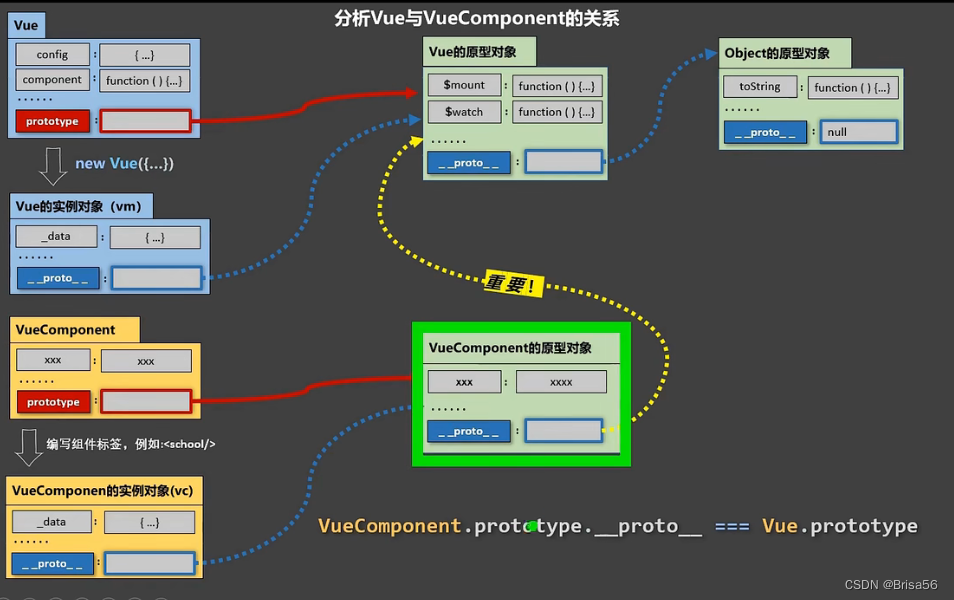
2.3.单文件组件
一个文件中只包含有1个组件
2.3.1.一个.vue文件的组成(三部分)
<!-- 1.模板页面 -->
<template>
页面模板
</template>
<!--2. JS 模块对象 -->
<script>
export default {
data() {
return {
}
},
methods: {
},
computed: {
},
components: {
}
}
</script>
<!--3. 样式 -->
<style>
样式定义
</style>
2.3.2.基本使用
- 引入组件
先写好xxx.vue的组件,然后再App.vue中import该组件,并在App中的components添加它。 - 映射成标签
- 使用组件标签
<template>
<div>
<school></school>
<Student></Student>
</div>
</template>
<script>
// 引入组件
import School from "./School";
import Student from "./Student";
export default {
name: "App",
components: {
School,
Student,
},
};
</script>
<!-- <style>
</style> -->
3.使用VUE脚手架
3.1.初始化脚手架
1、第一步(仅第一次执行):全局安装@vue/cli。
- npm install -g @vue/cli
2、第二步:切换到你要创建项目的目录,然后使用命令创建项目 - vue create xxxx
3、第三步:启动项目 - npm run serve
备注:
- 如出现下载缓慢请配置 npm 淘宝镜像:
npm config set registry https://registry.npm.taobao.org - Vue 脚手架隐藏了所有 webpack 相关的配置,若想查看具体的 webpakc 配置,
请执行:vue inspect > output.js
3.2.脚手架文件结构
├── node_modules
├── public
│ ├── favicon.ico: 页签图标
│ └── index.html: 主页面
├── src
│ ├── assets: 存放静态资源
│ │ └── logo.png
│ │── component: 存放组件
│ │ └── HelloWorld.vue
│ │── App.vue: 汇总所有组件
│ │── main.js: 入口文件
├── .gitignore: git版本管制忽略的配置
├── babel.config.js: babel的配置文件
├── package.json: 应用包配置文件
├── README.md: 应用描述文件
├── package-lock.json:包版本控制文件
3.3.关于不同版本的Vue
- vue.js与vue.runtime.xxx.js的区别:
- vue.js是完整版的Vue,包含:核心功能 + 模板解析器。
- vue.runtime.xxx.js是运行版的Vue,只包含:核心功能;没有模板解析器。
- 因为vue.runtime.xxx.js没有模板解析器,所以不能使用template这个配置项,需要使用render函数接收到的createElement函数去指定具体内容。
3.4.vue.config.js配置文件
- 使用vue inspect > output.js可以查看到Vue脚手架的默认配置。
- 使用vue.config.js可以对脚手架进行个性化定制,详情见:https://cli.vuejs.org/zh
3.5.ref属性
- 被用来给元素或子组件注册引用信息(id的替代者)
- 应用在html标签上获取的是真实DOM元素,应用在组件标签上是组件实例对象(vc)
- 使用方式:
- 打标识:
<h1 ref="xxx">.....</h1>或<School ref="xxx"></School> - 获取:
this.$refs.xxx
- 打标识:
3.6.props配置项
-
功能:让组件接收外部传过来的数据
-
传递数据:
<Demo name="xxx"/> -
接收数据:
-
第一种方式(只接收):
props:['name'] -
第二种方式(限制类型):
props:{name:String} -
第三种方式(限制类型、限制必要性、指定默认值):
props:{ name:{ type:String, //类型 required:true, //必要性 default:'老王' //默认值 } }
备注:props是只读的,Vue底层会监测你对props的修改,如果进行了修改,就会发出警告,若业务需求确实需要修改,那么请复制props的内容到data中一份,然后去修改data中的数据。
-
3.7.mixin(混入)
-
功能:可以把多个组件共用的配置提取成一个混入对象
-
使用方式:
第一步定义混合:
{ data(){....}, methods:{....} .... }第二步使用混入:
全局混入:
Vue.mixin(xxx)
局部混入:mixins:['xxx']
3.8.插件
-
功能:用于增强Vue
-
本质:包含install方法的一个对象,install的第一个参数是Vue,第二个以后的参数是插件使用者传递的数据。
-
定义插件:
对象.install = function (Vue, options) { // 1. 添加全局过滤器 Vue.filter(....) // 2. 添加全局指令 Vue.directive(....) // 3. 配置全局混入(合) Vue.mixin(....) // 4. 添加实例方法 Vue.prototype.$myMethod = function () { ...} Vue.prototype.$myProperty = xxxx } -
使用插件:
Vue.use()
3.9.scoped样式
- 作用:让样式在局部生效,防止冲突。
- 写法:
<style scoped>
题外话:
vue脚手架不直接支持less,用 npm i less-loader@7 下载安装依赖
这个@7是限制版本
<style lang="less"></style>
3.10.总结TodoList案例
-
组件化编码流程:
(1).拆分静态组件:组件要按照
功能点拆分,命名不要与html元素冲突。 (2).实现动态组件:考虑好
数据的存放位置,数据是一个组件在用,还是一些组件在用: 1).一个组件在用:放在组件自身即可。
2). 一些组件在用:放在他们共同的父组件上(状态提升)。
(3).实现交互:从绑定事件开始。
-
props适用于:
(1).父组件 ==> 子组件 通信
(2).子组件 ==> 父组件 通信(要求父先给子一个函数)
-
使用v-model时要切记:v-model绑定的值不能是props传过来的值,因为props是不可以修改的!
-
props传过来的若是对象类型的值,修改对象中的属性时Vue不会报错,但不推荐这样做。
3.11.webStorage
-
存储内容大小一般支持5MB左右(不同浏览器可能还不一样)
-
浏览器端通过
Window.sessionStorage和Window.localStorage属性来实现本地存储机制。 -
相关API:
-
xxxxxStorage.setItem('key', 'value');
该方法接受一个键和值作为参数,会把键值对添加到存储中,如果键名存在,则更新其对应的值。 -
xxxxxStorage.getItem('person'); 该方法接受一个键名作为参数,返回键名对应的值。
-
xxxxxStorage.removeItem('key'); 该方法接受一个键名作为参数,并把该键名从存储中删除。
-
xxxxxStorage.clear() 该方法会清空存储中的所有数据。
-
-
备注:
- SessionStorage存储的内容会随着浏览器窗口关闭而消失。
- LocalStorage存储的内容,需要手动清除才会消失。
xxxxxStorage.getItem(xxx)如果xxx对应的value获取不到,那么getItem的返回值是null。JSON.parse(null)的结果依然是null。
3.12.组件的自定义事件
-
一种组件间通信的方式,适用于:子组件 ===> 父组件
-
使用场景:A是父组件,B是子组件,B想给A传数据,那么就要在A中给B绑定自定义事件(事件的回调在A中)。
-
绑定自定义事件:
-
第一种方式,在父组件中:
<Demo @atguigu="test"/>或<Demo v-on:atguigu="test"/> -
第二种方式,在父组件中:
<Demo ref="demo"/> ...... mounted(){ this.$refs.xxx.$on('atguigu',this.test) } -
若想让自定义事件只能触发一次,可以使用
once修饰符,或$once方法。
-
-
触发自定义事件:
this.$emit('atguigu',数据) -
解绑自定义事件
this.$off('atguigu') -
组件上也可以绑定原生DOM事件,需要使用
native修饰符。 -
注意:通过
this.$refs.xxx.$on('atguigu',回调)绑定自定义事件时,回调要么配置在methods中,要么用箭头函数,否则this指向会出问题!
3.13.全局事件总线(GlobalEventBus)
-
一种组件间通信的方式,适用于任意组件间通信。
-
安装全局事件总线:
new Vue({ ...... beforeCreate() { Vue.prototype.$bus = this //安装全局事件总线,$bus就是当前应用的vm }, ...... }) -
使用事件总线:
-
接收数据:A组件想接收数据,则在A组件中给$bus绑定自定义事件,事件的回调留在A组件自身。
methods(){ demo(data){ ......} } ...... mounted() { this.$bus.$on('xxxx',this.demo) } -
提供数据:
this.$bus.$emit('xxxx',数据)
-
-
最好在beforeDestroy钩子中,用$off去解绑当前组件所用到的事件。
3.14.消息订阅与发布(pubsub)
-
一种组件间通信的方式,适用于任意组件间通信。
-
使用步骤:
-
安装pubsub:
npm i pubsub-js -
引入:
import pubsub from 'pubsub-js' -
接收数据:A组件想接收数据,则在A组件中订阅消息,订阅的回调留在A组件自身。
methods(){ demo(data){ ......} } ...... mounted() { this.pid = pubsub.subscribe('xxx',this.demo) //订阅消息 } -
提供数据:
pubsub.publish('xxx',数据) -
最好在beforeDestroy钩子中,用
PubSub.unsubscribe(pid)去取消订阅。
-
3.15.nextTick
- 语法:
this.$nextTick(回调函数) - 作用:在下一次 DOM 更新结束后执行其指定的回调。
- 什么时候用:当改变数据后,要基于更新后的新DOM进行某些操作时,要在nextTick所指定的回调函数中执行。
3.16.Vue封装的过度与动画
-
作用:在插入、更新或移除 DOM元素时,在合适的时候给元素添加样式类名。
-
图示:
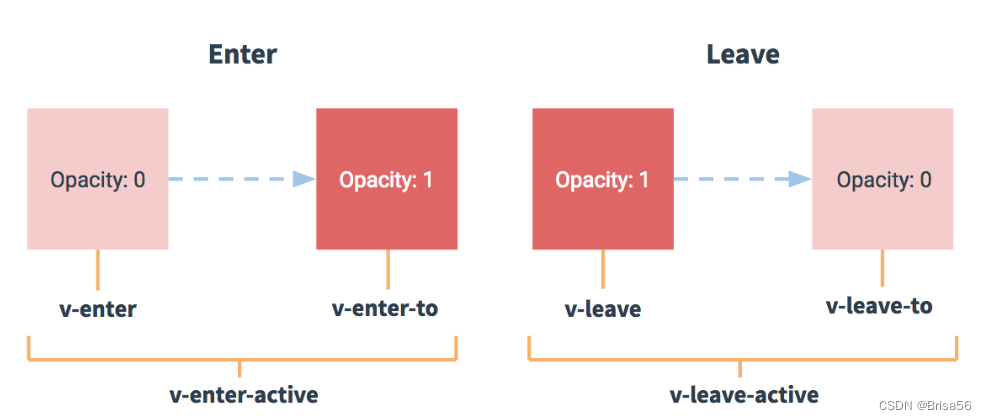
-
写法:
-
准备好样式:
- 元素进入的样式:
- v-enter:进入的起点
- v-enter-active:进入过程中
- v-enter-to:进入的终点
- 元素离开的样式:
- v-leave:离开的起点
- v-leave-active:离开过程中
- v-leave-to:离开的终点
- 元素进入的样式:
-
使用
<transition>包裹要过度的元素,并配置name属性:<transition name="hello"> <h1 v-show="isShow">你好啊!</h1> </transition> -
备注:若有多个元素需要过度,则需要使用:
<transition-group>,且每个元素都要指定key值。
-